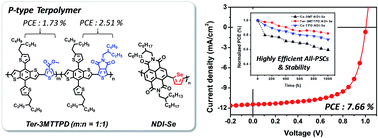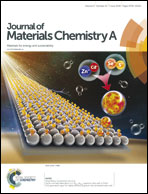Highly efficient and highly stable terpolymer-based all-polymer solar cells with broad complementary absorption and robust morphology†
Abstract
A novel conjugated terpolymer referred to as Ter-3MTTPD was successfully synthesized using 4,8-bis(5-(2-ethylhexyl)thiophen-2-yl)benzo[1,2-b:4,5-b′]dithiophene as a donor and methyl thiophene-3-carboxylate (3MT) and 5-(2-ethylhexyl)-4H-thieno[3,4-c]pyrrole-4,6(5H)-dione (TPD) as acceptor units to investigate the effects of the terpolymer structure on the optical and electrochemical properties. The performance of an all-polymer solar cell (all-PSC) was comprehensively examined by blending the terpolymer with 2,7-bis(2-hexyldecyl)-4-(selenophen-2-yl)benzo[lmn][3,8]phenanthroline-1,3,6,8(2H,7H)-tetraone (NDI-Se). The as-cast blend film of Ter-3MTTPD:NDI-Se exhibits the highest power conversion efficiency of 7.66% in the all-PSC. This was further supported by the results of time-resolved photoluminescence (TRPL) in Ter-3MTTPD:NDI-Se blend film states which yielded the highest PL quenching efficiency (90%) resulting from the shortest average lifetime, τave of ∼67 ps, much smaller than those of the two binary copolymer blend films (e.g., τave = 194 ps and 149 ps, respectively, for Co-3MT:NDI-Se and Co-TPD:NDI-Se). In addition, for an as-cast blend film of Ter-3MTTPD:NDI-Se in the active layer, the shelf-life (∼1000 h) of the all-PSC under ambient conditions was found to be much better compared to those of PSCs based on the other two binary copolymers, Co-3MT and Co-TPD.



 Please wait while we load your content...
Please wait while we load your content...